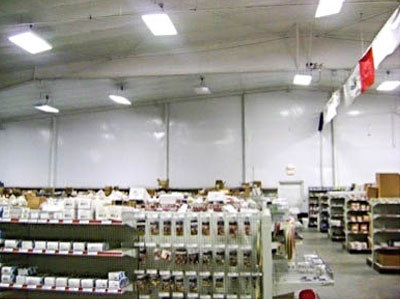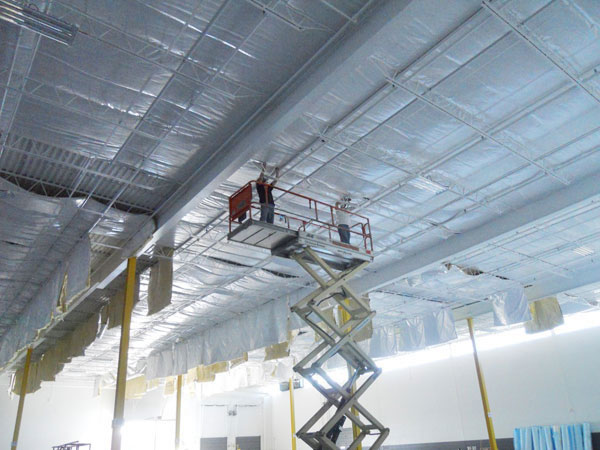Your Top Retrofit Questions Answered
Before and after: The Portsmouth Abbey School ice rink in Portsmouth, RI.
Do your customers ever ask about retrofit insulation systems? Do you have questions of your own about the process? Rest assured: You’re not alone.
Over the years, many contractors and building owners have come to Therm-All for their most complicated commercial building retrofit jobs. I receive many inquiries about insulation retrofit projects, so I thought I’d take a break from writing about commercial energy codes for this post and instead answer some of your top retrofit questions. A big thanks to Mark Diksas of The Northview Group (a partner of Therm-All’s), who shared his insights – knowledge that he’s gleaned from over 20 years worth of retrofit experience – throughout this post.
1. When is it time for a building owner to inquire about an insulation retrofit?
Before the retrofit: Decaying insulation board in a 47,000-square foot metal building in Franklin, Conn.
Another way to phrase this question is, “What are the top reasons for an insulation retrofit”? Below are a few, among many:
- Poor existing insulation: If the insulation already installed in the building is old, damaged or is causing building performance issues, it’s time for a retrofit.
- No existing insulation: If the building doesn’t have any insulation installed, serious condensation complications can arise.
- HVAC updates: Changes to a building’s heating or air conditioning system often require an insulation retrofit.
- Building use or ownership changes: Over the years, we’ve prescribed retrofits due to a change in the way a building will be used. For example, if an owner purchases an old welding shop and plans to use it as a farm building, the insulation system would need to be retrofitted.
- Fire damage: Smoked or scorched insulation requires a retrofit.
- Getting a building “up to code”: The evolving commercial energy codes landscape has created a need for higher R-values, so building owners are seeking insulation solutions with a maximum R-value.
2. What’s the most important question a building owner should ask before hiring an insulation retrofit specialist?
After the retrofit: The OptiLiner™ Banded Liner System transformed the interior space of F.W. Webb Company*,
New England’s largest plumbing and heating distributor.
“Have you ever done a building like mine, and can I visit it?” The retrofit process is very different for metal buildings versus a pole barn, so it matters whether or not the specialist has experience in your specific type of building. Also, seeing the specialist’s work in person trumps any pictures they’ll show you. It’s important to look closely at the application and check for quality.
Read about the F.W. Webb Company’s retrofit here.
3. How long does it take for a complete insulation retrofit in an “average” sized metal building?
In short: That’s variable. Factors such as whether or not there are machines on the ground can impact the length of time it takes to complete an insulation retrofit. On average, a retrofit specialist installs about 3,000 – 4,000 square feet of insulation per day.
4. What will the end result look like?
A brighter, improved appearance is how most building tenants describe the finished product.
Insulation retrofit systems also aid in:
- Sound abatement
- Condensation control
- Energy savings
- A more comfortable interior climate: Adding insulation to a building can keep the interior warmer in the winter and cooler in the summer (up to 10 – 15 degrees warmer/cooler without any additional HVAC updates).
5. Are all buildings candidates for insulation retrofit?
No, not all buildings qualify for insulation retrofit applications. In some cases, buildings have too many obstacles for the install to be a smooth, cost-effective process; buildings that house indoor pools are one example. It’s important to remember to choose an installation specialist who will give you an honest recommendation. A building should only be labeled viable for a retrofit after it has been visited by an insulation specialist or installer.
6. Commercial Building Insulation Requirements
Read our blog post on the current energy code landscape and what you need to know in 2023.
Want to make sure you don’t miss out on the latest energy code updates?
Subscribe to our energy code newsletter to get blog posts sent directly to your inbox.
MORE BLOGS
COMcheck™: A Live Demo with Bill “The Code Man” Beals
Join Bill “The Code Man” Beals Thursday, October 26th at 2:15 p.m. ET for a free COMcheck™ demonstration. Participants will earn 1 AIA LU/HSW and/or a certificate of completion.
Mid-Year Energy Code Update
I’ve been on the move and traveling the country, giving energy code presentations and attending industry meetings. In this mid-year energy code update, I’m sharing the trends I’ve observed from state to state, with a focus on the challenges and opportunities the IECC 2021/ASHRAE 90.1-2019 energy code cycle poses for metal building contractors, erectors, and designers.
Commercial Energy Codes & MBI: What to Know In 2023
Happy 2023, folks. We’re kicking off the new year with something a little different: A video summary of the current energy code landscape, plus what you need to know as we move into 2023. I also cover the metal building insulation systems that meet the most...
This Just In: Several States Adopt New Commercial Energy Codes
It’s officially the start of fall, folks, and you know what that means: A quick commercial energy code wrap-up. Here’s a short-and-sweet update on what’s been happening around the country. Also, are you attending METALCON? Join me for a free AIA-accredited course on...
Commercial Energy Code Update: What to Know for 2022
Learn more about the top commercial energy code updates you need to know for 2022.
2020 Code Update: Taking A Look At The Remainder Of The Year
Let’s dive into the top building envelope code updates you need to know for the rest of 2020.
Metal Buildings & Energy Codes: A Webinar With The Code Man
Join me Thursday, November 14th at 1 p.m. ET for a free webinar on the metal building envelope code changes you need to know. Participants will earn 1 AIA LU/HSW and/or a certificate of completion.
2019 Commercial Energy Codes Update
I got together with the folks at Metal Construction News and Metal Architecture to organize a webinar that will summarize the key commercial energy code information I’ve talked about over the past year.
IECC 2015 And ASHRAE 90.1-2013: What You Need To Know
The next commercial energy code cycle for most states is the IECC 2015 code and ASHRAE 90.1-2013 alternative path.
Your Top Air Barrier Questions Answered + MaxTight™
Answering Your Questions, Plus Our New Air Barrier System
A Closer Look at Air Barriers:
What are the new air barrier requirements? Find out in this post.
Commercial Energy Codes Update for 2016
Let’s take a look at the top commercial energy code updates you should know for 2016.
Air Barrier Requirements for Commercial Code Compliance
Air barriers for metal buildings: A primer.
The Code Man Talks Compliance for Fenestrations
Doors, windows, and skylights, oh my! Let’s talk compliance for fenestrations.
Commercial Energy Code Changes Throughout 2014
There’s a new ASHRAE Standard and IECC Code: Let’s get into it.





